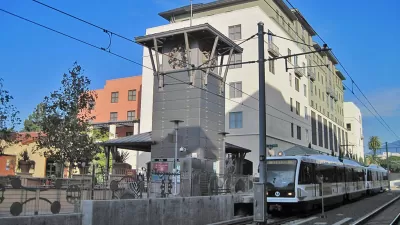The Southern California Association of Governments, in response to new mandates from the state, has adopted a radical new approach to housing requirements in Los Angeles, Orange, Riverside, and San Bernardino counties.

"In a dramatic shift to how Southern California cities plan to grow over the next decade, a regional agency decided Thursday to push for more housing in coastal rather than inland communities," reports Liam Dillon.
"Under the plan, communities in Los Angeles and Orange counties will have to accommodate more than 1 million new houses — more than triple the amount of both Riverside and San Bernardino counties. Culver City, for example, will have to zone for 3,300 new homes, more than double the number than under an alternative plan, which would have given a much larger responsibility for new housing to the Inland Empire."
As noted by Dillon, the Regional Housing Needs Assessment process is required by a 50-year-old law, but has long failed to live up to the intentions of the law. In the past year, under the tenure of new Governor Gavin Newsom, the state has been more willing to hold regions and cities to their commitments. Governor Newsom has threatened to withhold funding and the state has sued cities. Another law, SB 828, approved in 2018, implemented reforms of the RHNA process. State Senator Scott Wiener, the author of SB 828, took to Twitter the day after SCAG's vote to credit the law with the regional planning agency's change of planning strategy.
Dillon also notes that SB 828 that planned growth is not the same thing as actual growth, but that if and when cities start zoning for more housing, it will represent a significant step forward achieving the goals of SB 828.
Dillon documents the proceedings, with opinions cited from either side of the debate, of a contentious SCAG hearing. Perhaps surprisingly, the meeting concluded with resounding support for the new approach to regional housing in the form of a 43-19 vote. The housing targets set by the vote [pdf]—broken down by county, subregion, and city—is also available online.
FULL STORY: Coastal cities give in to growth. Southern California favors less housing in Inland Empire

Maui's Vacation Rental Debate Turns Ugly
Verbal attacks, misinformation campaigns and fistfights plague a high-stakes debate to convert thousands of vacation rentals into long-term housing.

Planetizen Federal Action Tracker
A weekly monitor of how Trump’s orders and actions are impacting planners and planning in America.

In Urban Planning, AI Prompting Could be the New Design Thinking
Creativity has long been key to great urban design. What if we see AI as our new creative partner?

Pedestrian Deaths Drop, Remain Twice as High as in 2009
Fatalities declined by 4 percent in 2024, but the U.S. is still nowhere close to ‘Vision Zero.’

King County Supportive Housing Program Offers Hope for Unhoused Residents
The county is taking a ‘Housing First’ approach that prioritizes getting people into housing, then offering wraparound supportive services.

Researchers Use AI to Get Clearer Picture of US Housing
Analysts are using artificial intelligence to supercharge their research by allowing them to comb through data faster. Though these AI tools can be error prone, they save time and housing researchers are optimistic about the future.
Urban Design for Planners 1: Software Tools
This six-course series explores essential urban design concepts using open source software and equips planners with the tools they need to participate fully in the urban design process.
Planning for Universal Design
Learn the tools for implementing Universal Design in planning regulations.
planning NEXT
Appalachian Highlands Housing Partners
Mpact (founded as Rail~Volution)
City of Camden Redevelopment Agency
City of Astoria
City of Portland
City of Laramie




























